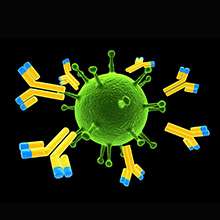Antibody affinity is decisive in Type 1 diabetes in adults

Patients with LADA – a form of autoimmune type 1 diabetes in adulthood – can be distinguished from patients with non-autoimmune type 2 diabetes by means of the antibody reaction affinity to the enzyme glutamic acid decarboxylase (GAD). Scientists from the Helmholtz Zentrum Munchen have reported in the journal Diabetes Care that high-affinity GAD antibodies are found in patients who produce only a little of their own insulin and who will require insulin therapy after only a relatively short time.
LADA (latent autoimmune diabetes in adults) is a form of type 1 diabetes in adulthood. Like the childhood form, the insulin-producing beta cells of the pancreas are destroyed by the body's own immune system. The progression of the illness is relatively slowly, however, with clinical manifestations not appearing until after the age of 30 and the patients not yet requiring insulin therapy to control blood sugar levels at the beginning of the disease. It is therefore often difficult to differentiate between LADA and type 2 diabetes.
Scientists from the Institute of Diabetes Research at the Helmholtz Zentrum München, partners in the Deutsches Zentrum für Diabetesforschung (DZD - German Center for Diabetes Research), have now examined the extent to which the GAD antibody affinity, as a measure of the maturity of the immune response, improves the classification of diabetes in adulthood. They also wanted to determine if vaccination with GAD influences the antibody affinity.
High antibody affinity identifies type 1 diabetes
Together with national and international colleagues, the team headed by PD Dr. Peter Achenbach, Stephanie Krause and Prof. Dr. Anette-Gabriele Ziegler examined the GAD antibody affinity in 46 LADA patients who participated in a GAD vaccination study. The study participants were injected under the skin with different doses of GAD or a placebo preparation in order to induce immune system tolerance to the beta cells. Interestingly, the GAD antibody affinity differed considerably even before the treatment, so that it was possible to distinguish between patients with high and low affinity. The patients with high GAD antibody affinity displayed low insulin production, in keeping with advanced autoimmune destruction of the beta cells. This patient group frequently needed insulin therapy after just a relatively short time. Patients with low affinity, on the other hand, displayed a considerably higher level of insulin production, which remained constant over a time frame of 30 months. The GAD antibody affinity was not influenced by the vaccination with GAD.
"Our findings show that the GAD antibody affinity is a valuable new diagnostic marker in LADA patients. As with childhood type 1 diabetes, we can forecast the progression of the disease and adapt the therapeutic measures accordingly," lead investigator Achenbach explains. "The antibody affinity should now also be taken into consideration in clinical studies involving LADA patients."
More information: Krause, S. et al. (2014): "GAD Autoantibody Affinity in Adult Patients with Latent Autoimmune Diabetes, the Study Participants of a GAD65 Vaccination Trial," Diabetes Care, DOI: 10.2337/dc13-1719















